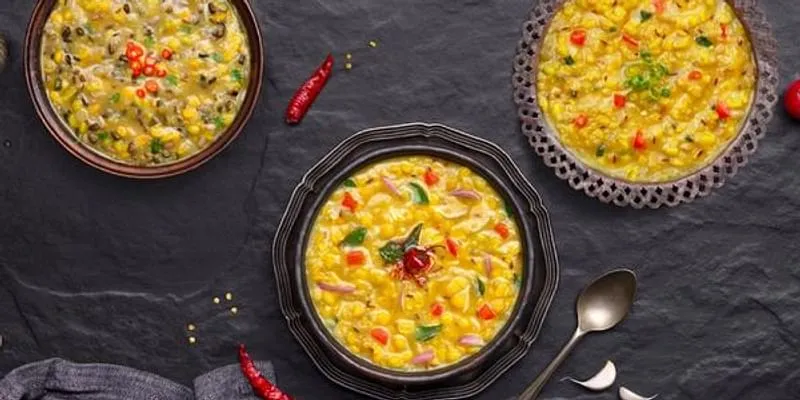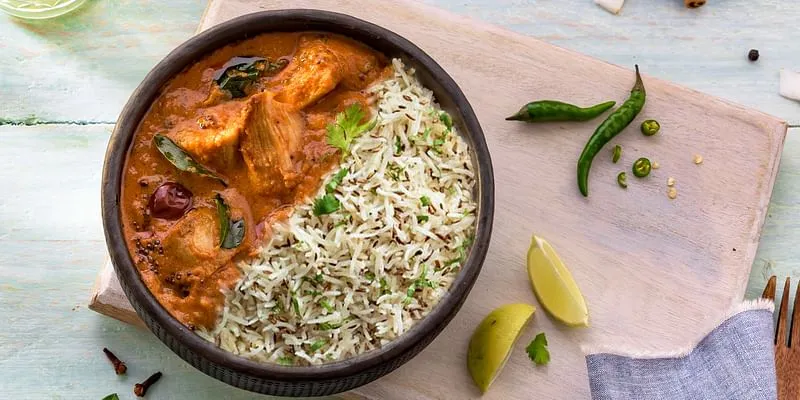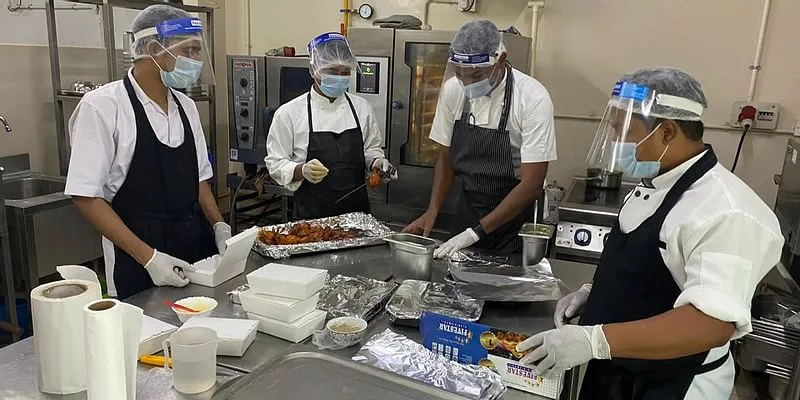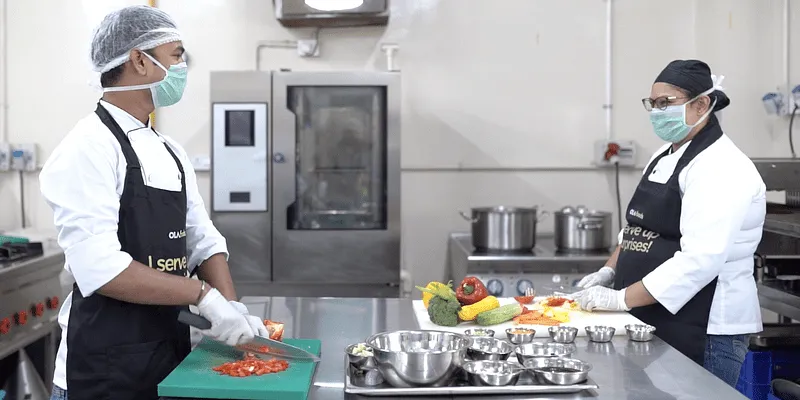Inside Ola Foods’ big bet on cloud kitchens and contactless delivery in the new normal
With its multi-brand kitchen model, Ola Foods is betting on favourable tailwinds, cloud kitchens, and contactless food delivery. It is also working with partners to start food delivery through drones.
Ride-hailing unicorn Ola launched its food business, Foods, in 2019. With its flagship brand Khichdi Experiment, Ola Foods made a blockbuster entry into the food segment.
Pranay Jivrajka, CEO, Ola Foods, says, “Khichdi Experiment is India’s fastest food brand to reach one million orders and one of the fastest growing categories on all platforms.”
But within just a year of its launch, the company faced financial and operational challenges due to the coronavirus pandemic. However, with its multi-brand kitchen model, the company is betting on favourable tailwinds, cloud kitchens, and contactless food delivery to stay afloat during these tough times.

Pranay Jivrajka, CEO, Ola Foods | Image Source: Ola Foods
Recently, YourStory caught up with Pranay to trace the journey of Ola Foods and its plans for the future.
One dish at a time
Back in 2017, Ola acquired Foodpanda India for $200 million to enter the online food delivery business. Rumour was that it was taking on Uber, its biggest competitor, that had already launched UberEATS (later acquired by ).
However, these speculations were put to rest when Ola launched its own brand - Ola Foods. “Our learnings from the past have helped us in building a sustainable food business that goes beyond food delivery and captures other parts of the food value chain,” Pranay says.
Speaking on the inspiration behind the launch of Khichdi Experiment, its first cloud kitchen product, Pranay says, the brand wanted to start its food journey by reimagining khichdi. Started with the aim to create a differentiator in a cluttered market, Khichdi Experiment has been able to acquire a dominant market share of around 80 percent in the online kitchen category within just one year of its launch.

Ola Food's Khichdi Experiment has been able to acquired around 80 percent market share within just one year of its launch | Image Source: Ola Foods
Commenting on why they entered the food business, Pranay says, India has considerably low restaurants per capita when compared to China, and only a couple of large restaurant chains.
“With Ola Foods, we wanted to cater to this segment through our network of cloud kitchens to enable brands to optimise costs, scale rapidly, and build consumer-first food brands in every market,” he adds.
India has a handful of national food brands, and thus brands like Ola Foods have got an opportunity to build a portfolio of food brands to serve customers’ needs.
“Our approach is to create new categories and redefine existing food categories to deliver a differentiated consumer experience,” Pranay adds.
At present, Ola Foods has a network of more than 50 tech-enabled smart kitchens and four brands across cities like Chennai, Hyderabad, Bengaluru, Delhi, Mumbai, and Pune. The startup is now focussing on expanding its presence across the country.
Apart from khichdi, it plans to build new categories including biryani, pizza, health, and meal kits. “We have already launched some of these brands across select markets and will be scaling them in the next few months,” Pranay says.
Check what goes behind an Ola Foods cloud kitchens in the video below:
Experimenting with food
Ola Foods claims to be experimenting with local ingredients and flavours and is offering over 20 variants of khichdi. From classic regional variants like Pav Bhaji to healthy substitutes like quinoa, Khichdi Experiment is making the comfort food exciting.
“We have taken inputs from our customers and recently launched khichdi in a range of exciting international flavours like Mexican and Italian,” Pranay says. The price for a bowl of khichdi starts from Rs 139.
Ola Foods has further expanded its offerings and has added two more brands under its umbrella -- Paratha Experiment and Bowlsome. Pranay says the success of Khichdi Experiment enabled the team to create a playbook to build other brands.
With Paratha Experiment, it aims to redefine the traditional paratha and make it an all-day meal. Ola Foods also enables customers to select from 20 plus parathas with regional, fusion, and international flavours.

Bowlsome's Mangalorean Chicken Curry | Image Source: Ola Foods
Bowlsome is its rice bowls brand. It offers single-person meals including regional bowls like Gatta Curry, Tamatar Sev, Papad ki Sabzi, and soon to be launched range of continental bowls.
Ola Foods is also planning to launch a Biryani brand as well. “It intends to enrich the biryani experience for consumers with a range of regional flavour-inspired biryanis,” Pranay says.
The company said it makes use of services like Zomato and to enable smooth-delivery of orders.
Standardising meals
Ola Foods follows a multi-brand kitchen model. The cloud kitchens are 2,000 sq ft in size. “The operational model is designed in such a way that each kitchen can service eight to ten brands and has the capability to scale operations basis the requirement,” Pranay says.
With technology being the core of its DNA, the company has heavily invested in ‘precision cooking’ methods and technologies to ensure consistency in every order. Its smart kitchens are tech-enabled and 100 percent electric with digitised cooking equipments. It uses artificial intelligence (AI) to connect the kitchen equipment and further enable automation and personalisation of food.
Further, the company says it has increased automation in various aspects of food preparation to ensure each dish is cooked at the right temperature and for the right amount of time.

Inside Ola Foods' cloud kitchen | Image Source: Ola Foods
The team has 350 employees to ensure quality food is delivered.
Food business during pandemic
During the coronavirus-led national lockdown, online food delivery declined as most people were not sure how safe ordering in was. While Ola Foods faced its own set of challenges, Pranay says, there has been favourable tailwinds as well.
“Under the current scenario, there has been a shift in the consumption behaviour of customers with the need clearly shifting towards more trusted brands,” he says. He adds that Ola Foods is well placed to cater to this.
The company is also working to ensure quality and safety of its food. It has a comprehensive weekly audit in place done by a third party to monitor kitchen safety and hygiene practices. Ola Foods is also working with partners to monitor kitchen quality processes through AI driven imaging solutions.
Ola Foods believes that contactless dining is here to stay even after the situation becomes relatively normal.
“We believe that contactless delivery through drones would be the next frontier of logistics and we are working closely with partners on pilot it soon,” Pranay reveals.

Inside Ola Foods cloud kitchen | Image Source: Ola Foods
Cloud kitchens are here to stay
According to Mordor Intelligence, the Indian Foodservice market is forecasted to reach $95.75 billion by 2025, registering a CAGR of 10.3 percent between 2020 and 2025. However, post COVID-19, dining-out has endured a setback.
“With strong tailwinds from food delivery and now the pandemic, the cloud kitchen market is poised to grow rapidly to $3 billion by 2023,” Pranay says.
A recent report by RedSeer Management Consulting suggests the cloud kitchen business was valued at $400 million in 2019 and is expected to become a $2 billion industry in India by 2024.
Thus, it is a great opportunity for cloud kitchens to expand their services and cater to customers with emphasis on maintaining standards in food-handling, packaging, and delivery.
“We believe online food delivery is still in a very high growth phase and the market is going to expand for the next three to five years,” Pranay says. He sees Ola Foods competing with home kitchens and intends to become the go-to food platform for consumers.
Ola Foods' immediate goal is to expand its network of kitchens. “We currently cover 35 to 40 percent of the food delivery customers, and we plan to expand our coverage to serve 75 to 80 percent of the urban food delivery demand,” Pranay adds.
It is also planning to launch new brands in the following months to expand its portfolio.
Edited by Megha Reddy










